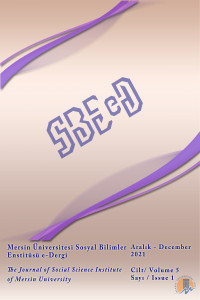Öz
Corpus can be described as a database for the purpose of research. Corpus studies have now been used in nearly every field of linguistics since the 1970s and gradually becoming a part of linguistic terminology. In present study cursing elements of Turkish Language were searched employing Turkish National Corpus. Cursing is an interesting subject matter that attracts several areas of linguistics not only micro fields such as, semantics, and syntax but also macro divisions such as psycholinguistics, discourse and pragmatics. In this study, we attempt to investigate the unique features of the curse utterances in Turkish and variations across regions, to understand if social variables such as age, gender and education level have influence on what cursing structures are used, and to find out whether survey results and national corpus are consistent in curse utterances. Data was collected via Turkish National Corpus and survey was developed based on array of research questions and applied to 170 participants. The findings derived from corpus and survey indicate similar features as particular curse words such as beddua (cursing), kahretsin (damn) and bela (trouble-evil) observed more often than kargış (imprecation), ilenme (cursing), mahvetsin (ruin). In parallel with the survey result, the most frequently used curse utterances in the Turkish National Corpus were Allah belanı versin, Allah cezanı versin, kahretsin (damn you, God punish you, damn it). In addition, distinctive curse structures varying from region to region were conceived.
Anahtar Kelimeler
Kaynakça
- Atmaca, E. (2019). Antalya Ağizlarinda Dua Ve Beddualar. Avrasya Uluslararası Araştırmalar Dergisi, 7(19), 42–80.
- Austin, J. L. (1962). How to doThings with Words. Harvard University.
- Beyazıt, D. Y. (2019). Karacaören Köyü Halkiyat Ve Harsi̇yatindan Bi̇r Nebze: Kargişlar Ve Alkişlar. Harsiyât, 3(5).
- Biber, D. E. (2012). Corpus-based and corpus-driven analyses of language variation and use. In The Oxford handbook of linguistic analysis. Oxford University Press.
- Devi, C. S. (2019). An Ethno-Linguistic Study of Curse Utterances in Meitei Society of Manipur.
- Ersöz, S. (2011). Türki̇ye Türkçesi̇ni̇n Doğu Grubu Ağizlarinda Beddualarin İşlevleri̇ Ve Cümle Yapilari Arasindaki̇ İli̇şki̇. Electronic Turkish Studies, 6(1).
- Mertens, D. M. (2014). Research and evaluation in education and psychology: Integrating diversity with quantitative, qualitative, and mixed methods. Sage publications.
- Nezakat-Alhossaini, M., & Esslami-Rasekh, A. (2013). “May Bread Run and You Run After It”: The Function of Cursing in Persian. Procedia-Social and Behavioral Sciences, 70, 517–525.
- Strowick, E. (2016). Curse and Modernity: A Brief Introduction. MLN, 131(3), 571–578.
- Turkish National Corpus (TNC). (n.d.). Retrieved April 10, 2020, from https://www.tnc.org.tr/
- Uysal, Y. (2019). Adıyaman Halk Kültüründe Dua ve Beddualar (Alkışlar-Kargışlar). Türkiyat Mecmuası, 29(2), 17–18.
- Vanci-Osam, Ü. (1998). May you be shot with greasy bullets: Curse utterances in Turkish. Asian Folklore Studies, 71–86.
Öz
Corpus can be described as a database for the purpose of research. Corpus studies have now been used in nearly every field of linguistics since the 1970s and gradually becoming a part of linguistic terminology. In present study cursing elements of Turkish Language were searched employing Turkish National Corpus. Cursing is an interesting subject matter that attracts several areas of linguistics not only micro fields such as, semantics, and syntax but also macro divisions such as psycholinguistics, discourse and pragmatics. In this study, we attempt to investigate the unique features of the curse utterances in Turkish and variations across regions, to understand if social variables such as age, gender and education level have influence on what cursing structures are used, and to find out whether survey results and national corpus are consistent in curse utterances. Data was collected via Turkish National Corpus and survey was developed based on array of research questions and applied to 170 participants. The findings derived from corpus and survey indicate similar features as particular curse words such as beddua (cursing), kahretsin (damn) and bela (trouble-evil) observed more often than kargış (imprecation), ilenme (cursing), mahvetsin (ruin). In parallel with the survey result, the most frequently used curse utterances in the Turkish National Corpus were Allah belanı versin, Allah cezanı versin, kahretsin (damn you, God punish you, damn it). In addition, distinctive curse structures varying from region to region were conceived.
Anahtar Kelimeler
Corpus-Based Approach Curse Utterances Speech Act theory Local Cursing Terminology
Kaynakça
- Atmaca, E. (2019). Antalya Ağizlarinda Dua Ve Beddualar. Avrasya Uluslararası Araştırmalar Dergisi, 7(19), 42–80.
- Austin, J. L. (1962). How to doThings with Words. Harvard University.
- Beyazıt, D. Y. (2019). Karacaören Köyü Halkiyat Ve Harsi̇yatindan Bi̇r Nebze: Kargişlar Ve Alkişlar. Harsiyât, 3(5).
- Biber, D. E. (2012). Corpus-based and corpus-driven analyses of language variation and use. In The Oxford handbook of linguistic analysis. Oxford University Press.
- Devi, C. S. (2019). An Ethno-Linguistic Study of Curse Utterances in Meitei Society of Manipur.
- Ersöz, S. (2011). Türki̇ye Türkçesi̇ni̇n Doğu Grubu Ağizlarinda Beddualarin İşlevleri̇ Ve Cümle Yapilari Arasindaki̇ İli̇şki̇. Electronic Turkish Studies, 6(1).
- Mertens, D. M. (2014). Research and evaluation in education and psychology: Integrating diversity with quantitative, qualitative, and mixed methods. Sage publications.
- Nezakat-Alhossaini, M., & Esslami-Rasekh, A. (2013). “May Bread Run and You Run After It”: The Function of Cursing in Persian. Procedia-Social and Behavioral Sciences, 70, 517–525.
- Strowick, E. (2016). Curse and Modernity: A Brief Introduction. MLN, 131(3), 571–578.
- Turkish National Corpus (TNC). (n.d.). Retrieved April 10, 2020, from https://www.tnc.org.tr/
- Uysal, Y. (2019). Adıyaman Halk Kültüründe Dua ve Beddualar (Alkışlar-Kargışlar). Türkiyat Mecmuası, 29(2), 17–18.
- Vanci-Osam, Ü. (1998). May you be shot with greasy bullets: Curse utterances in Turkish. Asian Folklore Studies, 71–86.
Ayrıntılar
| Birincil Dil | İngilizce |
|---|---|
| Bölüm | Makaleler |
| Yazarlar | |
| Yayımlanma Tarihi | 27 Aralık 2021 |
| Gönderilme Tarihi | 17 Temmuz 2021 |
| Yayımlandığı Sayı | Yıl 2021 Cilt: 5 Sayı: 1 |


